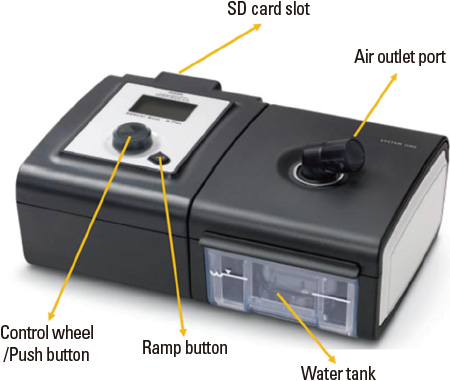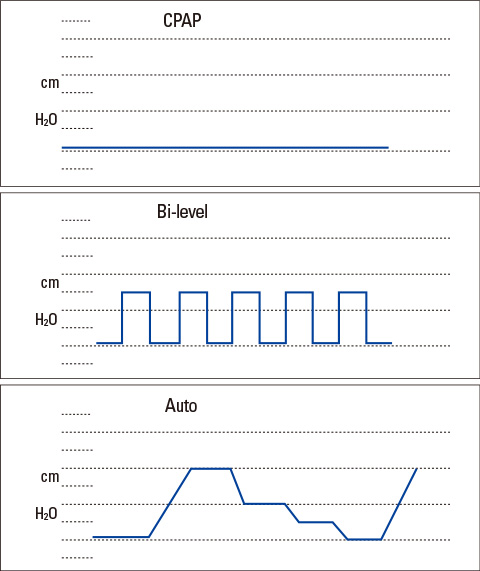Hanyang Med Rev.
2013 Nov;33(4):239-245. 10.7599/hmr.2013.33.4.239.
Treatment of Obstructive Sleep Apnea with Positive Pressure Ventilation
- Affiliations
-
- 1Department of Otorhinolaryngology-Head and Neck Surgery, Hanyang University College of Medicine, Seoul, Korea. shcho@hanyang.ac.kr
- KMID: 2284441
- DOI: http://doi.org/10.7599/hmr.2013.33.4.239
Abstract
- Continuous positive airway pressure (CPAP) is the gold-standard treatment for moderate to severe obstructive sleep apnea (OSA). Before CPAP therapy, optimal pressure to relieve any airway obstructive events (apnea, hypopnea, respiratory effort-related arousals, and snoring) should be measured during the second polysomnography. The main benefits of CPAP use are 1) elimination of airway obstructions regardless of sleep stages and positions during sleep, 2) amelioration of daytime and nocturnal symptoms, 3) decreased incidence and progression of systemic co-morbidities such as cardiovascular diseases, and 4) decreased incidence of accident-related traumas and mortality related to somnolence caused by OSA. Although CPAP is the most reliable and effective treatment for OSA, lack of patient acceptance and compliance may limit the CPAP use. To solve these problems, it is very important to educate patients and manage complications associated with mask and pressure-related discomforts as early as possible.
MeSH Terms
Figure
Cited by 2 articles
-
Sleep and Health
Seok Hyun Cho
Hanyang Med Rev. 2013;33(4):187-189. doi: 10.7599/hmr.2013.33.4.187.Effect of Doctor and Device Manager on Adherence with Positive Airway Pressure Therapy in Obstructive Sleep Apnea Patients
Seon Lin Kim, Ji-a Kim, Deok-Soo Kim, Min-Gyu Jo, Sung-Dong Kim, Kyu-Sup Cho
J Rhinol. 2018;25(1):26-31. doi: 10.18787/jr.2018.25.1.26.
Reference
-
1. Sullivan CE, Issa FG, Berthon-Jones M, Eves L. Reversal of obstructive sleep apnoea by continuous positive airway pressure applied through the nares. Lancet. 1981; 1:862–865.
Article2. Kuna ST, Bedi DG, Ryckman C. Effect of nasal airway positive pressure on upper airway size and configuration. Am Rev Respir Dis. 1988; 138:969–975.
Article3. Schwab RJ, Pack AI, Gupta KB, Metzger LJ, Oh E, Getsy JE, et al. Upper airway and soft tissue structural changes induced by CPAP in normal subjects. Am J Respir Crit Care Med. 1996; 154:1106–1116.
Article4. Kushida CA, Chediak A, Berry RB, Brown LK, Gozal D, Iber C, et al. Clinical guidelines for the manual titration of positive airway pressure in patients with obstructive sleep apnea. J Clin Sleep Med. 2008; 4:157–171.5. Sforza E, Krieger J, Bacon W, Petiau C, Zamagni M, Boudewijns A. Determinants of effective continuous positive airway pressure in obstructive sleep apnea. Role of respiratory effort. Am J Respir Crit Care Med. 1995; 151:1852–1856.
Article6. Sullivan CE, Issa FG, Berthon-Jones M, McCauley VB, Costas LJ. Home treatment of obstructive sleep apnoea with continuous positive airway pressure applied through a nose-mask. Bull Eur Physiopathol Respir. 1984; 20:49–54.7. Nino-Murcia G, McCann CC, Bliwise DL, Guilleminault C, Dement WC. Compliance and side effects in sleep apnea patients treated with nasal continuous positive airway pressure. West J Med. 1989; 150:165–169.8. Miljeteig H, Hoffstein V. Determinants of continuous positive airway pressure level for treatment of obstructive sleep apnea. Am Rev Respir Dis. 1993; 147:1526–1530.
Article9. Bureau MP, Series F. Comparison of two in-laboratory titration methods to determine effective pressure levels in patients with obstructive sleep apnoea. Thorax. 2000; 55:741–745.
Article10. Berry RB, Parish JM, Hartse KM. The use of auto-titrating continuous positive airway pressure for treatment of adult obstructive sleep apnea. An American Academy of Sleep Medicine review. Sleep. 2002; 25:148–173.11. Morgenthaler TI, Aurora RN, Brown T, Zak R, Alessi C, Boehlecke B, et al. Practice parameters for the use of autotitrating continuous positive airway pressure devices for titrating pressures and treating adult patients with obstructive sleep apnea syndrome: an update for 2007. An American Academy of Sleep Medicine report. Sleep. 2008; 31:141–147.
Article12. Epstein LJ, Kristo D, Strollo PJ Jr, Friedman N, Malhotra A, Patil SP, et al. Clinical guideline for the evaluation, management and long-term care of obstructive sleep apnea in adults. J Clin Sleep Med. 2009; 5:263–276.13. Engleman HM, Wild MR. Improving CPAP use by patients with the sleep apnoea/hypopnoea syndrome (SAHS). Sleep Med Rev. 2003; 7:81–99.
Article14. Randerath WJ, Galetke W, David M, Siebrecht H, Sanner B, Ruhle K. Prospective randomized comparison of impedance-controlled auto-continuous positive airway pressure (APAP [FOT]) with constant CPAP. Sleep Med. 2001; 2:115–124.
Article15. Rolfe I, Olson LG, Saunders NA. Long-term acceptance of continuous positive airway pressure in obstructive sleep apnea. Am Rev Respir Dis. 1991; 144:1130–1133.
Article16. Kakkar RK, Berry RB. Positive airway pressure treatment for obstructive sleep apnea. Chest. 2007; 132:1057–1072.
Article17. Jenkinson C, Davies RJ, Mullins R, Stradling JR. Comparison of therapeutic and subtherapeutic nasal continuous positive airway pressure for obstructive sleep apnoea: a randomised prospective parallel trial. Lancet. 1999; 353:2100–2105.
Article18. Sin DD, Mayers I, Man GC, Ghahary A, Pawluk L. Can continuous positive airway pressure therapy improve the general health status of patients with obstructive sleep apnea?: a clinical effectiveness study. Chest. 2002; 122:1679–1685.
Article19. McArdle N, Douglas NJ. Effect of continuous positive airway pressure on sleep architecture in the sleep apnea-hypopnea syndrome: a randomized controlled trial. Am J Respir Crit Care Med. 2001; 164:1459–1463.
Article20. Bardwell WA, Ancoli-Israel S, Berry CC, Dimsdale JE. Neuropsychological effects of one-week continuous positive airway pressure treatment in patients with obstructive sleep apnea: a placebo-controlled study. Psychosom Med. 2001; 63:579–584.
Article21. Peker Y, Hedner J, Norum J, Kraiczi H, Carlson J. Increased incidence of cardiovascular disease in middle-aged men with obstructive sleep apnea: a 7-year follow-up. Am J Respir Crit Care Med. 2002; 166:159–165.
Article22. Marin JM, Carrizo SJ, Vicente E, Agusti AG. Long-term cardiovascular outcomes in men with obstructive sleep apnoea-hypopnoea with or without treatment with continuous positive airway pressure: an observational study. Lancet. 2005; 365:1046–1053.
Article23. Becker HF, Jerrentrup A, Ploch T, Grote L, Penzel T, Sullivan CE, et al. Effect of nasal continuous positive airway pressure treatment on blood pressure in patients with obstructive sleep apnea. Circulation. 2003; 107:68–73.
Article24. Hedner J, Darpo B, Ejnell H, Carlson J, Caidahl K. Reduction in sympathetic activity after long-term CPAP treatment in sleep apnoea: cardiovascular implications. Eur Respir J. 1995; 8:222–229.
Article25. Chin K, Ohi M, Kita H, Noguchi T, Otsuka N, Tsuboi T, et al. Effects of NCPAP therapy on fibrinogen levels in obstructive sleep apnea syndrome. Am J Respir Crit Care Med. 1996; 153:1972–1976.
Article26. Lavie L, Kraiczi H, Hefetz A, Ghandour H, Perelman A, Hedner J, et al. Plasma vascular endothelial growth factor in sleep apnea syndrome: effects of nasal continuous positive air pressure treatment. Am J Respir Crit Care Med. 2002; 165:1624–1628.
Article27. Schulz R, Mahmoudi S, Hattar K, Sibelius U, Olschewski H, Mayer K, et al. Enhanced release of superoxide from polymorphonuclear neutrophils in obstructive sleep apnea. Impact of continuous positive airway pressure therapy. Am J Respir Crit Care Med. 2000; 162:566–570.
Article28. Sassani A, Findley LJ, Kryger M, Goldlust E, George C, Davidson TM. Reducing motor-vehicle collisions, costs, and fatalities by treating obstructive sleep apnea syndrome. Sleep. 2004; 27:453–458.
Article29. He J, Kryger MH, Zorick FJ, Conway W, Roth T. Mortality and apnea index in obstructive sleep apnea. Experience in 385 male patients. Chest. 1988; 94:9–14.
Article
- Full Text Links
- Actions
-
Cited
- CITED
-
- Close
- Share
- Similar articles
-
- The Role of Endothelin-1 in Obstructive Sleep Apnea Syndrome and Pulmonary Hypertension
- Surgical Treatment of Adult Obstructive Sleep Apnea
- Massive REM Rebound on Continuous Positive Airway Pressure in Obstructive Sleep Apnea
- A Sleepy Man with Chronic Obstructive Pulmonary Disease-Obstructive Sleep Apnea Overlap Syndrome
- CPAP Treatment in Pediatric Obstructive Sleep Apnea





